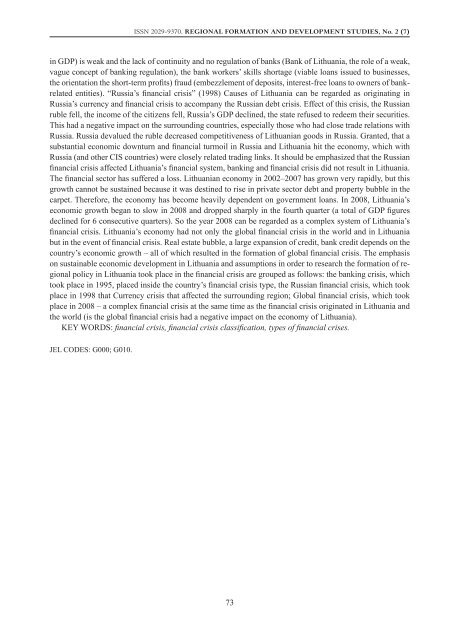regional formation and development studies - KlaipÄdos universitetas
regional formation and development studies - KlaipÄdos universitetas
regional formation and development studies - KlaipÄdos universitetas
You also want an ePaper? Increase the reach of your titles
YUMPU automatically turns print PDFs into web optimized ePapers that Google loves.
ISSN 2029-9370. Regional Formation <strong>and</strong> Development Studies, No. 2 (7)<br />
in GDP) is weak <strong>and</strong> the lack of continuity <strong>and</strong> no regulation of banks (Bank of Lithuania, the role of a weak,<br />
vague concept of banking regulation), the bank workers’ skills shortage (viable loans issued to businesses,<br />
the orientation the short-term profits) fraud (embezzlement of deposits, interest-free loans to owners of bankrelated<br />
entities). “Russia’s financial crisis” (1998) Causes of Lithuania can be regarded as originating in<br />
Russia’s currency <strong>and</strong> financial crisis to accompany the Russian debt crisis. Effect of this crisis, the Russian<br />
ruble fell, the income of the citizens fell, Russia’s GDP declined, the state refused to redeem their securities.<br />
This had a negative impact on the surrounding countries, especially those who had close trade relations with<br />
Russia. Russia devalued the ruble decreased competitiveness of Lithuanian goods in Russia. Granted, that a<br />
substantial economic downturn <strong>and</strong> financial turmoil in Russia <strong>and</strong> Lithuania hit the economy, which with<br />
Russia (<strong>and</strong> other CIS countries) were closely related trading links. It should be emphasized that the Russian<br />
financial crisis affected Lithuania’s financial system, banking <strong>and</strong> financial crisis did not result in Lithuania.<br />
The financial sector has suffered a loss. Lithuanian economy in 2002–2007 has grown very rapidly, but this<br />
growth cannot be sustained because it was destined to rise in private sector debt <strong>and</strong> property bubble in the<br />
carpet. Therefore, the economy has become heavily dependent on government loans. In 2008, Lithuania’s<br />
economic growth began to slow in 2008 <strong>and</strong> dropped sharply in the fourth quarter (a total of GDP figures<br />
declined for 6 consecutive quarters). So the year 2008 can be regarded as a complex system of Lithuania’s<br />
financial crisis. Lithuania’s economy had not only the global financial crisis in the world <strong>and</strong> in Lithuania<br />
but in the event of financial crisis. Real estate bubble, a large expansion of credit, bank credit depends on the<br />
country’s economic growth – all of which resulted in the <strong>formation</strong> of global financial crisis. The emphasis<br />
on sustainable economic <strong>development</strong> in Lithuania <strong>and</strong> assumptions in order to research the <strong>formation</strong> of <strong>regional</strong><br />
policy in Lithuania took place in the financial crisis are grouped as follows: the banking crisis, which<br />
took place in 1995, placed inside the country’s financial crisis type, the Russian financial crisis, which took<br />
place in 1998 that Currency crisis that affected the surrounding region; Global financial crisis, which took<br />
place in 2008 – a complex financial crisis at the same time as the financial crisis originated in Lithuania <strong>and</strong><br />
the world (is the global financial crisis had a negative impact on the economy of Lithuania).<br />
KEY WORDS: financial crisis, financial crisis classification, types of financial crises.<br />
JEL codes: G000; G010.<br />
73

















